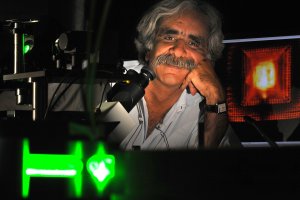Aug 17 2009
A UC Irvine center that aims to make real-time videos of single molecules in action has been awarded $20 million over five years from the National Science Foundation.
 Chemist V. Ara Apkarian and colleagues will attempt to be the first ever to record time-lapse images of single molecules. His team was awarded $20 million from the National Science Foundation toward this goal. Photo by Daniel A. Anderson / University Communications
Chemist V. Ara Apkarian and colleagues will attempt to be the first ever to record time-lapse images of single molecules. His team was awarded $20 million from the National Science Foundation toward this goal. Photo by Daniel A. Anderson / University Communications
UCI's Chemistry at the Space-Time Limit is one of three NSF Centers for Chemical Innovation. Its scientists hope to become the first ever to record time-lapse images of single molecules - a feat that has proved elusive because size and time scales are so small. Success would greatly accelerate the pace of nanoscience, which is driving the miniaturization of technologies ranging from computers to radios to satellites.
"If you can see a single molecule in action, then you can intervene, control and direct what it does," said UCI chemist V. Ara Apkarian, center director. "UCI is ahead of the curve. We're starting to image the motion of molecules, and we've developed methods that sense motion on length scales smaller than the nucleus of an atom."
A video-capture rate of 1 million billion frames per second (about 30 frames per second is the standard TV video rate) is required for molecules, and each frame must be taken with magnification 10,000 times higher than the best existing optical microscope. UCI researchers are building instruments capable of this.
Scientists believe observing individual molecule behavior will demystify important aspects of chemistry. Out of billions of molecules the same shape and size, only particular ones will ignite a desired reaction. For example, certain gold particles catalyze the conversion of carbon monoxide to carbon dioxide, but which ones and how remain subjects of debate. Knowing this would enable chemists to design and manufacture more efficient, environmentally friendly catalysts.
"In many cases, the ensemble is not important, but the individual is," Apkarian said. "This also happens in real life. In a group of people, one person's action may determine the course of the whole. If we only look at average behavior, we will miss how an outlier controls the fate of everyone involved."
Single-molecule devices such as transistors, radios and chemical sensors are currently being developed, and the industry is growing.
"This is engineering at the ultimate atomistic limit," Apkarian said. "There's no question the tools that enable the observation and manipulation of one molecule at a time will be the pillars on which the field of nanotechnology will be built."
The Chemistry at the Space-Time Limit center hopes to make available online eventual videos of small-scale chemistry and is planning an outreach program with the Discovery Science Center in Santa Ana, Calif.
In addition to Apkarian, UCI faculty members Wilson Ho, Philip Collins, Eric Potma, Nien-Hui Ge, Douglas Mills and Filipp Furche belong to the center, along with Guillermo Bazan of UC Santa Barbara and Richard Van Duyne of Northwestern University.